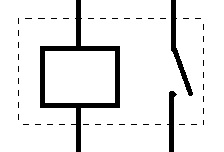We talked about how the transistor acts like an electronic switch, but the problem here is that the transistor cannot handle, (as in physically, cannot handle will get too hot and melt) huge currents, also in some projects you may want to physically isolate some parts of the circuit away from other parts.
You may for example have a circuit that has parts exposed where you might touch them, but it's ok as it's very low voltages, but elsewhere in the circuit you may be using mains voltages to turn on a light, in this case what you need to use is a relay.
A relay is a kind of electronic switch. The traditional relay is made with two normal switch contacts,one of these is held in a fixed position whilst the other is on a stiff sprung arm, but is able to move.
Traditional relays have a electro magnet contained inside, when activated this electro magnet pulls the sprung arm towards it, either opening or closing switch contacts. The symbol for a relay is a small box to indicate the electromagnet with a normal switch symbol alongside this, the switch contacts are contained inside a dotted outline to show that they are controlled by the relay.

No comments:
Post a Comment